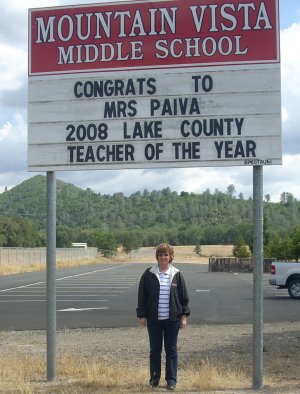- Lake County News Reports
- Posted On
Paiva receives Teacher of the Year honors

LAKE COUNTY – The county's best teachers recently were honored with special recognition for their achievements.
Each year the county's school districts select one outstanding teacher as their District Teacher of the Year. A Blue Ribbon Committee of community leaders then interviews these candidates.
The criteria for selection of the County Teacher of the Year is based upon the state and national requirements. These include professional development activities, commitment to the improvement of the educational system, personal attributes, creativity and ability to communicate ideas effectively as well as professional skills in delivering curriculum and instruction to students.
This year's committee members were Wally Holbrook, Madelene Lyon, Kate Lyons and Marc Morita. The committee chair was Chris Thomas, county deputy superintendent of schools.
Mountain Vista Middle School teacher Joyce Paiva was named 2008-09 Lake County Teacher of the Year.
Paiva was born in Illinois, but grew up in what she says used to be small town Morgan Hill where she commuted to Norte Dame High School. She moved to the city of San Jose after high school graduation to attend San Jose State University, where she majored in English.
She says she “knew she had a talent for writing and really enjoyed the literary aspect of the major” so it was a natural choice to choose this area of study.
While in college, Paiva worked at a large bank part-time and was offered a full-time position before she received her bachelor's degree. She felt she needed a greater challenge and while she was trying to figure out what her next step would be, she received a flier in the mail from San Jose State University that described a program called Project 70.
The college was taking applications for a special education program and would accept 70 students. She decided to give it a go, was accepted, and thus Paiva’s teaching career was born.
Paiva has taught in Lake County since 1971 with her first job student teaching kindergarten and third grade. She has taught various grade levels, with the past 12 years of her career spent teaching sixth through eighth grades at Mountain Vista Middle School.
Currently, Paiva teaches seventh and eighth grade math, which she finds very challenging and rewarding. Her goal is “to have each student reach their highest level and establish a strong mathematical foundation.”
“It is a day-to-day challenge, making sure they understand each and every step,” she said.
Mountain Vista Middle School Principal John Berry gave Paiva high marks.
"Joyce Paiva is an outstanding instructor who is well liked and highly respected,” he said. “She is totally dedicated to her students and continues to grow as an educator. Her commitment to academic excellence has not only benefited her many students over the years, but has also been an inspiration to the faculty at Mountain Vista Middle School."
In addition to this honor, Paiva has received recognition for her outstanding teaching by the California State Senate and Assembly, the United States Congress, the California League of Middle Schools and was named the 2002 Kelseyville District Teacher of the Year.
Other teachers honored as outstanding District Teachers of the Year for 2008-09 are Cindy Beasley, Lakeport Unified School District; Robann Hill, Konocti Unified District; Kathy Hughes, Lucerne Elementary District; Janice Klier, Upper Lake Elementary District; Christina Moore, Upper Lake High District; and Bob Norris, Middletown Unified District.
Paiva, along with the District Teachers of the Year, will be honored for their exceptional achievement at a dinner this fall.
For more information on the upcoming award dinner, please contact Janice Bailey at the Lake County Office of Education, 262-4102.
E-mail Caitlin Andrus at This email address is being protected from spambots. You need JavaScript enabled to view it..
{mos_sb_discuss:2}

 How to resolve AdBlock issue?
How to resolve AdBlock issue? 










